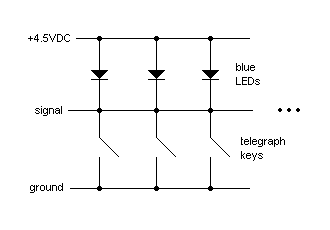Here is Bryan in his office with his telegraph station.
And here is Don in his office with the heart of GeekNet on his desk.

Each LED/key pair (arranged in columns in the schematic) belongs to one of the GeekNet participants. When any participant presses his telegraph key, all of the LEDs light up simultanously, because they are all wired in parallel. In essense, this is a telegraphic "party line". Therefore, it is important to establish a protocol for one person to call a particular other person on the network. We do this by assigning a unique calling code to each person on the network. For example, Bryan's code is a single "dit" repeated every few seconds, and Don's code is a pair of "dits" repeated every few seconds. When Don wants to call Bryan, he repeats Bryan's calling code until either Bryan answers, or Don gets tired of trying to call Bryan. If Bryan answers, he does so by holding down his key for a few seconds, causing all LEDs to stay on. Then the caller (Don) identifies himself using his own calling code (in this case, two dits). Then Bryan confirms that he is the intended recipient of the call by sending his calling code back a single time. This final step in the protocol might sound redundant, but it is useful in the case where someone other than the intended recipient is answering the call. Of course, spoofing is trivial, so the entire protocol operates on the honor system.